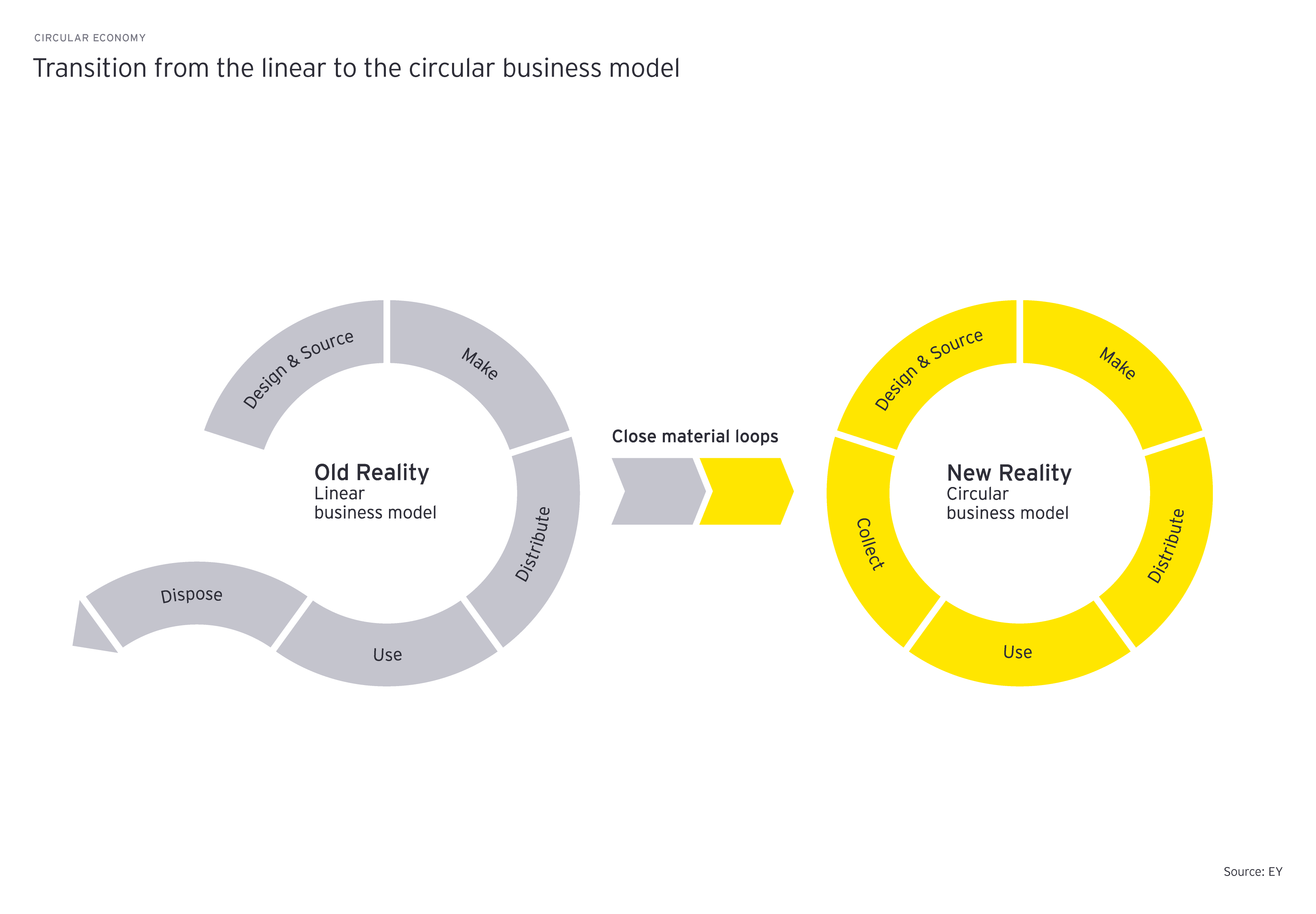EY refers to the global organization, and may refer to one or more, of the member firms of Ernst & Young Limited, each of which is a separate legal entity. Ernst & Young Limited is a Swiss company with registered seats in Switzerland providing services to clients in Switzerland.

Swiss companies should adopt circular business models to cope with risk factors, address sustainability and meet diverse stakeholder needs.
In brief
- In a volatile, complex and uncertain macroeconomic environment, companies recognize the benefits of the circular economy for more stability and resilience.
- Stakeholders like investors, regulators, employees and consumers are also demanding more sustainable products – and they want transparency to make decisions.
- We propose six guiding stars to help organizations navigate the first steps on their circularity journey.
Nowadays, companies are under pressure from a cocktail of risk factors and mega trends. As a result, organizations need to consider demands of key stakeholders from various spheres to arrive at informed business decisions. If the landscape of external influencing factors is analyzed, this process occurs to be complex since the depth of spheres and often contradicting stakeholder demands enlarged throughout recent years.
A good starting point to analyze the external impacts on companies are geopolitical frictions accelerated by the Ukraine invasion, which have led to immediate negative consequences for the global economy. Against this background commodity and energy supply restrictions, as well as associated price increases occurred and companies as well as nations were forced to adapt their strategies. For example, non-sustainable, fossil energy sources are back on the political agenda to meet short-term energy demand.
Taking a supply chain perspective, companies are confronted with massive disruptions, leading to delays or even non-delivery of products or services. On this note it is important to mention China’s ongoing zero-tolerance COVID-19 policy, which exacerbates the supply chain challenges. In combination with the current restrictive monetary policy, we see a rise of negative investor and consumer sentiment, which is triggering a withdrawal of capital from the market.
Even though the mentioned geopolitical tensions seem to be most pressing, global warming and its severe consequences on the societal and business environment have not lost their gravity. Therefore, the urgency of developing even more sustainable strategies is of utmost importance. Pressure to become more sustainable in Switzerland really comes into focus if one considers that we would need 2.8 planets to survive if every person in the world were to consume as much as an average person in Switzerland. [1]
Chapter 1
Push factors for the circular economy
How the circular economy responds to regulators, consumers and other stakeholders’ needs
The European and Swiss regulators are developing various legislation and directives to ensure carbon neutrality goals are achieved. They essentially require companies to increasingly build – and report transparently on – ESG-related structures and strategies. One example is the recently published, mandatory reporting requirements for Swiss companies from 2024 onwards.[7] This not only implies that companies are forced to redesign processes, but that stakeholders are gaining greater visibility on the activities of companies. It also means that the latter have more information to decide whether or not a company is worthy of their continued support. In other words: If organizations do not adapt, they will face a serious risk of losing financial, supply, collaborative, investment and consumption “support” across different stakeholder groups.
In this regard, it is important to add that these requirements do not focus solely on large companies, but SMEs as well. On the one hand, the regulator is taking a holistic approach and includes smaller companies in its regulations. On the other, SMEs face indirect pressure, especially when selling goods and services to large cap companies.
A further ingredient in the cocktail of negative external factors affecting companies is the changing behavior and demands of customers. EY’s future consumer index indicates that 56% percent of 18,000 consumers surveyed are paying attention to environmental impacts they are causing with their consuming behavior[2]. Meanwhile, inflation and the correlating loss of purchasing power leads to people buying cheaper alternatives. Consumers are re-focusing on essential products and services. Considering these aspects, a potential field of tension occurs, since to date, sustainable products are mostly more expensive than less-sustainable alternatives. Therefore, companies need to decide which alternatives to offer in the short term.
In the longer run, however, with ESG-related regulation coming into force, inflation returning to lower levels, and an increased supply of renewable energy which is cheaper than fossil fuels due to scaled technology and infrastructure the pressure to offer sustainable products will force companies to change strategies. Taking a broader view, the demands of employees as well as investors and suppliers support the longer-term, sustainable strategy. Incorporating the complexity of today’s business environment and underlying decision making-processes, organizations need to initiate change processes today, since organizational roadmaps are not changed overnight. This means that the short-term strategy should be a sustainable one as well. Embracing the circular economy is one-way organizations can start their strategic shift now.
Chapter 2
Spotlight on circular
What the circular economy means and how companies can embrace new opportunities
We observe a current megatrend toward the circular economy, offering far-reaching opportunities for companies, the economy and society as a whole. This type of business or ecosystem model allows companies, and its supply chain partners to create circular processes, therefore abandoning the disadvantageous take-make-waste approach. The key factor to consider is that circular models allow companies to financially benefit while introducing sustainable approaches to their operations. We outline opportunities to economically benefit from circular principles in chapter 3.

The figure above depicts the process of closing the supply chain loop. An analysis of differences between a conventional and circular supply chain reveals enormous environmental and economic implications when embracing the new reality.
Primarily, advantages within the environmental sphere of a company occur. Closing the loop requires supply chain partners to maximize the possibilities of repairing, refurbishing, up- or recycling products and materials to decrease the use of raw-materials, reduce waste and decrease CO2 emissions[3]. Considering the fact that within Switzerland 80-90 million tons of waste is generated every year, circular business models could radically reduce these figures[4].
Alongside the sustainable aspects of a circular economy, there’s also a huge opportunity for companies to increase profits in the long run.
Next to these aspects, the probability of fulfilling orders is enhanced, which boosts customer satisfaction. This is based on the fact that a decreased amount of virgin raw materials is required, lowering dependency on global supply chains and enabling scarce resources to be managed more efficiently. In turn, this may lead to long-term, highly profitable customer relationships and increased margins.
Chapter 3
Mitigating negative impact factors
How circular business models address some of today’s big challenges
Revising the negative impact factors on companies discussed at the beginning of this article, circular business strategies provide an attractive opportunity for companies to ease or even circumvent potential pressures – and further increase their profit potential.
With respect to geopolitical frictions and the problems of the global economy in particular, we see that companies adopting circular pathways benefit from growing deglobalization and better supply chain resilience. By keeping materials in the loop and leveraging “local” suppliers, companies are less dependent on foreign sources, which may be subject to further, negative geopolitical tensions such as invasions, trade wars, pandemic policies or unexpected events such as the Fukushima nuclear crisis or the blockage of the Suez Canal. Organizations can decrease raw material usage, increase stability of their product offerings and meet customer demand for locally sourced, sustainable products. It’s a win-win situation: Companies mitigate volatility of material supplies, increase customer satisfaction and improve margins.
Building on this, incoming ESG regulation and disclosures play to the advantage of companies. By implementing circular business models, companies are already well placed to comply with laws such as the ongoing partial revision of the Swiss environmental protection act which reinforces the circular economy and disclosures such as the counterproposal to the Responsible Business Initiative. Seen from this perspective, sustainability reports, product labels and marketing requirements are not a necessary evil but a preferred tool to communicate organizational activities. Especially where competitors fail to adopt circular, more sustainable business strategies, an organization can secure a unique, leading position. Further, there is no need of coming up with ideas on how to position the company well in such disclosures, which is by the way called green washing, but companies just must report on what they are doing while also considering goals set by countries or federation of states.
Chapter 4
Six guiding stars
How companies can start to incorporate circularity into their business model
In Switzerland, 12% of companies already have circular activities within their business model.[5] Most are about cutting material requirements, reducing negative environmental impacts from production processes and extending the useful life of internal production infrastructure.[6]
Switching to a circular business model requires a change of the whole company: new corporate strategies, amended target operating models, extended data management, new performance measurement models, revised supply chains as well as logistics functions and talent hiring processes. To successfully implement circularity, there is no one-size-fits-all solution. However, some aspects can serve as guiding stars. We propose six starting points to get your organization thinking about what circularity could do for your business:
Summary
In a world that remains uncertain and subject to pressures from all angles, organizations need to seek new, sustainable ways to remain resilient and profitable. The circular economy allows companies to mitigate risks by aligning economic demands with sustainable requirements. Embracing the circular economy will also be an important contribution to society’s efforts to tackle urgent climate change challenges. Swiss companies should start preparing to implement a circular strategy – for better business, easier ESG compliance and happier stakeholders.
Acknowledgments
We thank Vincent Metzler and Gloria Flik for their valuable contributions to this article.
Related articles



